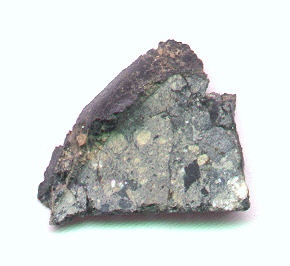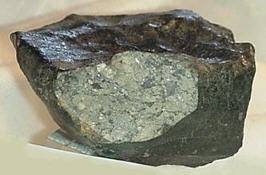DiogeniteDiogenites belong to the evolved achondrite HED group that also includes howardites and eucrites. They are named after the Greek philosopher Diogenes of Apollonia, of the 5th century BCE, who was the first to suggest that meteorites come from outer space (a realization forgotten for over 2,000 years). They are Click on Term to Read More
Polymict

Found 2001
no coordinates recorded A single, fusion-crusted stone weighing 237 g was purchased in Zagora, Morocco, in May of 2001. It was analyzed at several institutions in France, including Université d’Angers, Ifremer–Centre de Brest, Muséum National d’Histoire Naturelle, and Ecole Normale Supérieure de Lyon. Northwest Africa 1239 was classified as a rare polymict diogeniteDiogenites belong to the evolved achondrite HED group that also includes howardites and eucrites. They are named after the Greek philosopher Diogenes of Apollonia, of the 5th century BCE, who was the first to suggest that meteorites come from outer space (a realization forgotten for over 2,000 years). They are Click on Term to Read More, a group that comprises only a small number of identified samples, representing 8 out of 182 diogenitesDiogenites belong to the evolved achondrite HED group that also includes howardites and eucrites. They are named after the Greek philosopher Diogenes of Apollonia, of the 5th century BCE, who was the first to suggest that meteorites come from outer space (a realization forgotten for over 2,000 years). They are Click on Term to Read More studied by Warren et al. (2009).
Polymict diogenites have been defined as orthopyroxene-rich breccias containing small amounts of
maficOne of the two broad categories of silicate minerals, the other being felsic, based on its magnesium (Mg) and/or iron (Fe) content. Mafic indicates silicate minerals that are predominantly comprised of Mg and/or Fe.The term is derived from those major constituents: Magnesium + Ferrum (Latin for iron) + ic (having Click on Term to Read More lithic clasts or other
mineralInorganic substance that is (1) naturally occurring (but does not have a biologic or man-made origin) and formed by physical (not biological) forces with a (2) defined chemical composition of limited variation, has a (3) distinctive set of of physical properties including being a solid, and has a (4) homogeneous Click on Term to Read More fragments with wide ranges in texture and composition. The diogenite Aioun el Atrouss is polymict, containing large eucritic clasts, while the polymict Garland contains
orthopyroxeniteA rock composed primarily of orthopyroxene. Non-terrestrial orthopyoxenites include diogenites and a single martian meteorite, ALH 84001, that was found in the Allan Hills region of Antarctica in 1984. ALH 84001 is a cumulate rock consisting of 97% coarse-grained, Mg-rich orthopyroxene, with small amounts of plagioclase, chromite, and carbonate. It Click on Term to Read More from two distinct compositional groups—an FeO-rich, CaO-poor, low-Al and low-Cr group (I), and a low-FeO, CaO-rich, high-Al group (II). Clasts of magnesian
noriteIgneous rock composed of 90% plagioclase, 95% orthopyroxene (low-Ca pyroxene) and less than 10% olivine. Norite is most commonly found in the lunar (highlands) meteorites but has also been found in about a dozen diogenites, a few shergottites, and a very small number of other achondrite types. Gabbro is very Click on Term to Read More and
basaltBasalt is the most common extrusive igneous rock on the terrestrial planets. For example, more than 90% of all volcanic rock on Earth is basalt. The term basalt is applied to most low viscosity dark silicate lavas, regardless of composition. Basalt is a mafic, extrusive and fine grained igneous rock Click on Term to Read More have also been reported in Garland, as well as in the Peckelsheim diogenite. Another diogenite, Y-791073, has been tentatively described as polymict. Northwest Africa 1239 is a brecciated rock consisting of more than 90 vol% orthopyroxenite fragments, but contains a multitude of clasts and grains including eucritic
pyroxeneA class of silicate (SiO3) minerals that form a solid solution between iron and magnesium and can contain up to 50% calcium. Pyroxenes are important rock forming minerals and critical to understanding igneous processes. For more detailed information, please read the Pyroxene Group article found in the Meteoritics & Classification category. Click on Term to Read More, calcic
plagioclaseAlso referred to as the plagioclase feldspar series. Plagioclase is a common rock-forming series of feldspar minerals containing a continuous solid solution of calcium and sodium: (Na1-x,Cax)(Alx+1,Si1-x)Si2O8 where x = 0 to 1. The Ca-rich end-member is called anorthite (pure anorthite has formula: CaAl2Si2O8) and the Na-rich end-member is albite Click on Term to Read More (ranging to
anorthiteRare compositional variety of plagioclase and the calcium end-member of the plagioclase feldspar mineral series with the formula CaAl2Si2O8. Anorthite is found in mafic igneous rocks such as anorthosite. Anorthite is abundant on the Moon and in lunar meteorites. However, anorthite is very rare on Earth since it weathers rapidly Click on Term to Read More), and
olivineGroup of silicate minerals, (Mg,Fe)2SiO4, with the compositional endpoints of forsterite (Mg2SiO4) and fayalite (Fe2SiO4). Olivine is commonly found in all chondrites within both the matrix and chondrules, achondrites including most primitive achondrites and some evolved achondrites, in pallasites as large yellow-green crystals (brown when terrestrialized), in the silicate portion Click on Term to Read More, along with FeNi-metal, and
troiliteBrass colored non-magnetic mineral of iron sulfide, FeS, found in a variety of meteorites. Click on Term to Read More. It may be inferred that the source rock for this diogenite was situated in a
regolithMixture of unconsolidated rocky fragments, soil, dust and other fine granular particles blanketing the surface of a body lacking an atmosphere. Regolith is the product of "gardening" by repeated meteorite impacts, and thermal processes (such as repeated heating and cooling cycles). Click on Term to Read More setting.
The compositional variation present in NWA 1239 supports the theory that diogenites are
orthopyroxeneOrthorhombic, low-Ca pyroxene common in chondrites. Its compositional range runs from all Mg-rich enstatite, MgSiO3 to Fe-rich ferrosilite, FeSiO3. These end-members form an almost complete solid solution where Mg2+ substitutes for Fe2+ up to about 90 mol. % and Ca substitutes no more than ~5 mol. % (higher Ca2+ contents occur Click on Term to Read More cumulates resulting from
fractional crystallizationA crystallization process in which minerals crystallizing from a magma are isolated from contact with the liquid. It is a key process in the formation of igneous rocks during the process of magmatic differentiation. Also known as crystal fractionation. Click on Term to Read More in a number of compositionally distinct basaltic
magmaMolten silicate (rock) beneath the surface of a planetary body or moon. When it reaches the surface, magma is called lava. Click on Term to Read More sources. These diverse magmas, of which three orthopyroxenite classes have been identified—I, II, and III (Hewins, 1980)—were initially produced through moderate degrees of fractional melting or low degrees of
partial meltingAn igneous process whereby rocks melt and the resulting magma is comprised of the remaining partially melted rock (sometimes called restite) and a liquid whose composition differs from the original rock. Partial melting occurs because nearly all rocks are made up of different minerals, each of which has a different melting Click on Term to Read More (Shearer
et al., 1997). In contrast, only two distinct classes, corresponding to the two Garland lithologies, were identified through cluster analysis based on orthopyroxene composition data (Harriott and Hewins, 1984).
From these distinct lithologies, two separate CRE age trends have been defined, representing impacts at 14 m.y. and 24 m.y. ago, consistent with a minimal number of mixing events for diogenites. The 14 m.y. trend is consistent with ejection of all three lithologies plus the polymict members, while the 24 m.y. trend appears to have ejected the class III lithology (containing lower Cr compared to class II; e.g., Roda, ALHA77256, and Ibbenbühren) and polymict members.
Further details on the petrogenesis of diogenites can be found on the
Johnstown page. An
alternative classification system for the diogenites based on mineralogical and petrographical features has been proposed by Beck and McSween (2010), and modified by Wittke
et al. (2011). The photo above shows a 2.54 g partial slice of the polymict diogenite NWA 1239, while that below shows the
main massLargest fragment of a meteorite, typically at the time of recovery. Meteorites are commonly cut, sliced or sometimes broken thus reducing the size of the main mass and the resulting largest specimen is called the "largest known mass". Click on Term to Read More.

Photo courtesy of B. Fectay and C. Bidaut—
meteorite.fr








